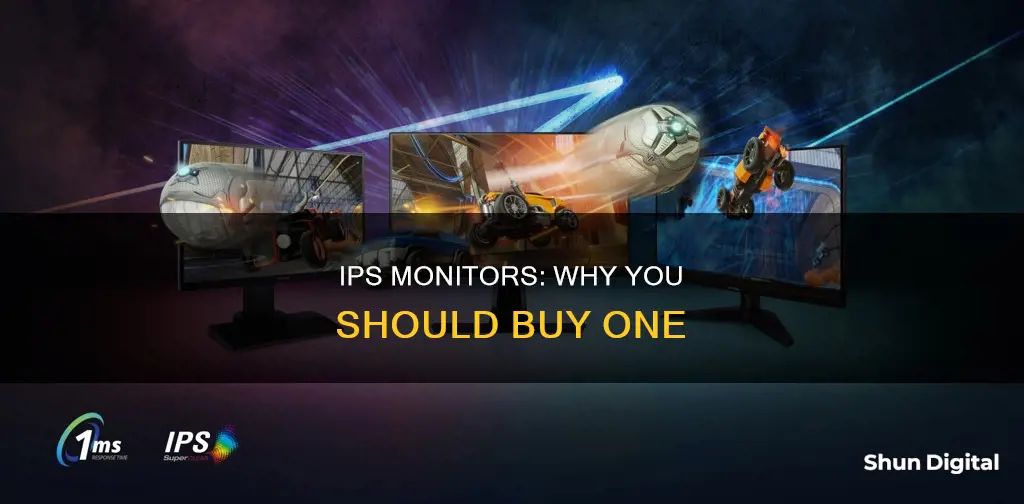
IPS monitors are becoming increasingly popular, but are they worth the hype? IPS stands for In-Plane Switching and is a type of display technology commonly seen on smartphones. IPS monitors are known for their high-quality visuals, brilliant colours, high contrast ratios, and wide viewing angles. They are particularly beneficial for creative professionals, photographers, videographers, and design engineers as they offer a wide colour gamut and accurate colour reproduction. IPS monitors are generally more expensive than TN monitors, but they offer richer colours and better viewing angles, making them the best all-round choice for most users. While IPS monitors may have slower response times than TN panels, there are high-quality IPS monitors available that are suitable for gaming. When purchasing an IPS monitor, it is important to consider factors such as response time, refresh rate, colour gamut, contrast ratio, and panel type. While cheaper IPS monitors may be tempting, it is crucial to remember that sacrificing build quality and features may lead to issues such as ghosting and poor image quality. Therefore, investing in a high-quality, expensive IPS monitor is generally a wiser decision.
| Characteristics | Values |
|---|---|
| Display quality | Higher |
| Colours | Richer |
| Viewing angles | Better |
| Response time | Slower |
| Cost | More expensive |
| Refresh rate | Higher |
| Resolution | Higher |
| Ghosting | Possible issue |
What You'll Learn

IPS monitors offer a wider colour gamut and are ideal for photo editing
IPS panels have a wider colour gamut than other types of panels, such as TN (twisted nematic) and VA (vertical alignment) panels. This means that IPS monitors can display a wider range of colours, which is crucial for photo editing. While TN panels offer a low manufacturing cost and short response time, their performance in colour, contrast, and viewing angles is comparatively weak. VA panels, on the other hand, offer excellent contrast and brightness but often have slower response times.
IPS monitors are widely considered the best choice for photo editing because they provide accurate and consistent colours, high contrast ratios, and wide viewing angles. This ensures that photographers and photo editors can trust that the colours they see on their screens accurately represent the colours in their images. Additionally, IPS monitors often have features such as built-in speakers, a range of input connectors, and adjustable stands or tiltable screens, providing further convenience and flexibility for users.
When choosing an IPS monitor for photo editing, it is important to consider factors such as screen size, resolution, colour accuracy, connectivity options, and price. Screen size and resolution play a crucial role in determining the level of detail and sharpness of the displayed image. Colour accuracy is of utmost importance to ensure that the colours on the screen match those in the final print or digital output. Connectivity options should be considered to ensure compatibility with your computer or laptop. Finally, setting a budget beforehand can help narrow down the options and find the best monitor that suits your needs and budget.
Troubleshooting Guide: Rebooting Your ASUS Monitor and G-SYNC
You may want to see also

They have better viewing angles than TN panels
IPS monitors have better viewing angles than TN panels. This is one of the biggest advantages of IPS monitors. No matter your vantage point to the computer monitor, an IPS panel helps deliver excellent colour and picture quality so that every part of the screen provides a stellar image. This is particularly important for creative professionals who rely on their displays to show accurate colours from edge to edge within their working space.
TN panels, on the other hand, suffer from poor viewing angles. If you're looking at a TN panel from an angle, you may notice colour degradation and inversion at extreme angles. This can be a problem if you're watching a movie on your laptop while lying down, for example.
IPS displays are also better for those who want to mount their monitors on a wall, as they can be viewed from a wider range of angles. This makes them a great solution as your primary computer monitor or additional screen.
IPS panels are also better for those who want a larger screen. On a smaller display, the impact of viewing angles is less noticeable, but on a larger display, colour shifting will be more significant, making it difficult to correctly colour creative works.
IPS panels also tend to have a faster response time than VA panels, which is another type of LCD panel.
IPS Monitors: How to Identify and Verify
You may want to see also

They are suitable for gamers, but with lower response times
IPS monitors are suitable for gamers but with lower response times than TN panels. IPS, or in-plane switching, is a type of liquid crystal display (LCD) where the liquid crystals are aligned in parallel. This alignment helps deliver excellent colour and picture quality from all viewing angles.
IPS panels are known for their superior colour accuracy and wide viewing angles. They also offer a faster response time than VA panels, which is important for gaming. While TN panels can be as low as 1ms, IPS panels typically range from 1-3ms for the fastest panels, with some going as low as 0.5ms.
IPS panels are a good choice for gamers who want a balance of image quality and response time. They are particularly well-suited to multiplayer gaming sessions, as their wide viewing angles and colour accuracy mean that multiple players can view the screen without any colour degradation.
IPS panels are also a good choice for gamers who are also creative professionals, as they offer accurate colour reproduction.
ASUS Monitor Light Bleed: Design Flaw or Unavoidable?
You may want to see also

IPS monitors are more expensive than TN panels
IPS panels provide superior colour accuracy, capable of displaying 16.7 million colours, compared to 262,144 colours on TN panels. This makes IPS panels ideal for professionals such as graphic designers and photographers, who require accurate colour representation. The wider viewing angles of IPS panels also ensure consistent colours and contrast even when viewed from side angles, whereas TN panels suffer from colour shifting and distortion when not viewed head-on.
Another factor contributing to the higher cost of IPS panels is their advanced technology. IPS stands for In-Plane Switching, which refers to the arrangement of pixels within the display. This technology improves viewing angles and colour reproduction but often results in slower response times compared to TN panels. While this makes IPS panels less ideal for competitive gaming, they are still suitable for casual gaming and can provide a satisfactory experience.
The higher price of IPS panels also reflects their durability. IPS panels are designed to last longer, with a typical lifespan of around 50,000 hours, compared to 40,000 to 50,000 hours for TN panels. While both types of panels are susceptible to physical damage, IPS panels offer superior colour accuracy and image quality that justifies their higher cost for users who require these features.
In summary, IPS panels are more expensive than TN panels due to their superior colour accuracy, wider viewing angles, advanced technology, and longer lifespan. These features make IPS panels ideal for professionals requiring accurate colour representation and those seeking a high-quality visual experience. TN panels, while more affordable, fall short in colour accuracy and viewing angles but excel in response times, making them a popular choice for gamers.
Connecting Your TV Monitor to a Comcast Cable Box
You may want to see also

They are ideal for creative professionals
IPS monitors are ideal for creative professionals. They are designed to improve on the flaws of TN technology, primarily in terms of poor viewing angles and colour reproduction. IPS displays have a wider colour gamut and are therefore able to reproduce extended colours found in the Adobe RGB and NTSC colour gamuts. This is a crucial feature for creative professionals, who rely on their displays to show accurate colours from edge to edge within their working space.
IPS monitors are also typically more expensive than TN monitors, but they produce much higher display quality, with better colours and viewing angles. The viewing angles are one of the top reasons to opt for an IPS monitor, as TN panels suffer from poor viewing angles, particularly in the vertical direction. If you are ever looking at your monitor from anything other than dead straight on, an IPS monitor is a better choice.
IPS monitors are also the best all-round choice, especially for creatives, and refresh rates are getting higher. They are considered one of the best computer monitors for graphic designers, photographers, videographers, and design engineers because of all the colours IPS monitors can capture. Not only is the colour captured accurately, but it is also captured consistently, making it easier for creatives and engineers to do their work.
IPS monitors are available in a wide range of styles and sizes, and many have features like HDMI outputs, headphone jacks, anti-glare flat-panel screens, adjustable bases, and tiltable screens.
HP Monitor Options: Sizes and Features Explored
You may want to see also







